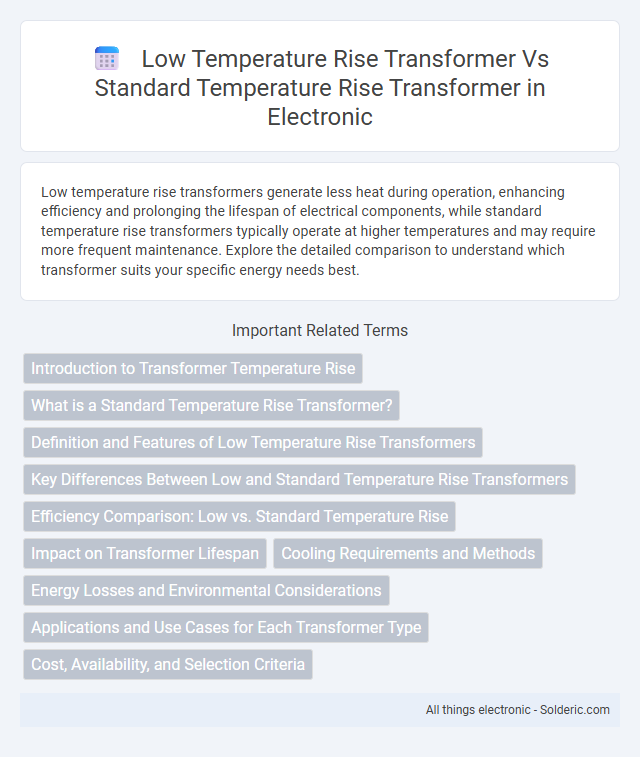Low temperature rise transformers generate less heat during operation, enhancing efficiency and prolonging the lifespan of electrical components, while standard temperature rise transformers typically operate at higher temperatures and may require more frequent maintenance. Explore the detailed comparison to understand which transformer suits your specific energy needs best.
Comparison Table
| Feature | Low Temperature Rise Transformer | Standard Temperature Rise Transformer |
|---|---|---|
| Temperature Rise | Reduced, typically <= 55degC above ambient | Standard, typically <= 65degC above ambient |
| Efficiency | Higher efficiency due to less copper and core losses | Normal efficiency standard as per design |
| Lifespan | Longer lifespan due to lower thermal stress | Standard lifespan with regular thermal aging |
| Cooling Requirement | Less cooling required; ideal for enclosed or sensitive environments | Standard cooling systems typically sufficient |
| Cost | Higher initial cost due to superior materials and design | Lower initial cost, more common |
| Applications | Hospitals, data centers, critical infrastructure | General industrial and commercial use |
Introduction to Transformer Temperature Rise
Transformer temperature rise is a critical factor indicating the increase in operating temperature above ambient levels, directly impacting efficiency and lifespan. Low temperature rise transformers typically exhibit a 55degC rise or less, compared to standard temperature rise transformers which usually have a 65degC or higher rise, reducing thermal stress and energy losses. Selecting low temperature rise transformers benefits applications requiring extended reliability and enhanced performance under continuous or heavy load conditions.
What is a Standard Temperature Rise Transformer?
A standard temperature rise transformer operates with a typical temperature increase of up to 65degC above ambient, designed to meet general electrical load demands efficiently. It features insulation materials and oil cooling systems rated for these temperatures, ensuring reliable performance under normal conditions. This type is widely used in residential, commercial, and industrial applications where typical load and environmental conditions are expected.
Definition and Features of Low Temperature Rise Transformers
Low temperature rise transformers are designed to operate with a maximum temperature increase significantly lower than standard temperature rise transformers, often limited to around 60degC compared to the typical 80degC or higher of standard units. These transformers use advanced insulation materials and enhanced cooling methods to minimize heat generation and improve efficiency, resulting in longer lifespan and reduced risk of overheating. Their features include improved thermal management, higher reliability in continuous operation, and suitability for sensitive electrical equipment requiring stable temperature conditions.
Key Differences Between Low and Standard Temperature Rise Transformers
Low temperature rise transformers operate at significantly cooler temperatures, typically 55degC or less, compared to standard transformers which often reach up to 80degC, enhancing lifespan and reducing insulation degradation risks. Your choice of a low temperature rise transformer results in increased energy efficiency, improved safety, and suitability for sensitive environments requiring stable thermal conditions. These transformers often feature advanced cooling techniques and superior insulation materials, distinguishing them in performance and reliability from standard temperature rise transformers.
Efficiency Comparison: Low vs. Standard Temperature Rise
Low temperature rise transformers maintain higher efficiency by reducing core and copper losses compared to standard temperature rise transformers, resulting in less energy dissipation as heat. The improved thermal performance extends the lifespan of components and supports consistent voltage regulation under varying load conditions. Your choice of a low temperature rise transformer can lead to lower operational costs and enhanced energy savings over time.
Impact on Transformer Lifespan
Low temperature rise transformers operate with a lower winding temperature compared to standard temperature rise transformers, significantly extending the insulation life and overall transformer lifespan by reducing thermal aging. You can expect low temperature rise transformers to provide enhanced reliability and durability in demanding electrical environments, as excessive heat is a primary factor in transformer degradation. Investing in a low temperature rise transformer ensures longer service intervals and lower maintenance costs due to improved thermal management.
Cooling Requirements and Methods
Low temperature rise transformers require less intensive cooling systems due to their enhanced insulation and design, which limit the internal temperature increase under load. Standard temperature rise transformers often rely on traditional cooling methods such as natural air cooling (AN) or oil-immersed cooling with radiators (ONAN), whereas low temperature rise models can use simpler cooling solutions, reducing installation and maintenance costs. Your choice of transformer impacts the cooling infrastructure needed, influencing overall energy efficiency and operational reliability.
Energy Losses and Environmental Considerations
Low temperature rise transformers exhibit reduced energy losses due to lower winding and core temperatures, which enhances efficiency and prolongs equipment lifespan. Standard temperature rise transformers typically have higher thermal stresses, resulting in increased resistive losses and more frequent maintenance requirements. The improved energy efficiency of low temperature rise transformers contributes to decreased greenhouse gas emissions and supports sustainable environmental practices.
Applications and Use Cases for Each Transformer Type
Low temperature rise transformers are ideal for applications requiring prolonged operation in confined spaces or environments with stringent thermal limits, such as medical equipment, data centers, and precision manufacturing. Standard temperature rise transformers suit general industrial power distribution, lighting systems, and commercial buildings where higher ambient temperatures and occasional overloads are expected. Choosing the appropriate transformer depends on the thermal performance needed to ensure reliability, efficiency, and safety in specific operational conditions.
Cost, Availability, and Selection Criteria
Low temperature rise transformers typically cost more upfront than standard temperature rise transformers due to advanced materials and enhanced cooling designs, but they offer longer lifespan and reduced maintenance costs. Standard temperature rise transformers have wider availability and a broader range of options, making them suitable for general applications where thermal limits are less critical. Your selection should prioritize operating environment, load conditions, and budget, with low temperature rise models preferred for high-demand, continuous operation to minimize heat-related degradation.
low temperature rise transformer vs standard temperature rise transformer Infographic

 solderic.com
solderic.com